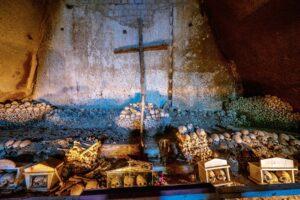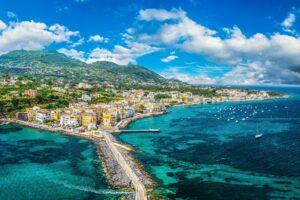Fodor's Expert Review San Francesco di Paola
Modeled after Rome's Pantheon, this circular basilica is the centerpiece of the Piazza Plebiscito and remains one of the most frigidly voluptuous examples of the Stile Empire, or Neoclassical style, in Italy. Commissioned by Ferdinand I to fulfill a vow he had made in order to enlist divine aid in being reinstated to the throne of the Kingdom of the Two Sicilies, it rose at one end of the vast parade ground built several years earlier by Joachim Murat. Completed in the late 1840s after 30 years of construction, it managed to transform Murat's inconveniently grandiose colonnade—whose architect was clearly inspired by the colonnades of St. Peter's in Rome—into a setting for restored Bourbon glory. Pietro Bianchi from Lugano in Switzerland won a competition and built a slightly smaller version of the Pantheon, with a beautiful coffered dome and a splendid set of 34 Corinthian columns in gray marble; but the overall lack of color (so different from the warm interior of the Pantheon),... READ MORE
Modeled after Rome's Pantheon, this circular basilica is the centerpiece of the Piazza Plebiscito and remains one of the most frigidly voluptuous examples of the Stile Empire, or Neoclassical style, in Italy. Commissioned by Ferdinand I to fulfill a vow he had made in order to enlist divine aid in being reinstated to the throne of the Kingdom of the Two Sicilies, it rose at one end of the vast parade ground built several years earlier by Joachim Murat. Completed in the late 1840s after 30 years of construction, it managed to transform Murat's inconveniently grandiose colonnade—whose architect was clearly inspired by the colonnades of St. Peter's in Rome—into a setting for restored Bourbon glory. Pietro Bianchi from Lugano in Switzerland won a competition and built a slightly smaller version of the Pantheon, with a beautiful coffered dome and a splendid set of 34 Corinthian columns in gray marble; but the overall lack of color (so different from the warm interior of the Pantheon), combined with the severe geometrical forms, produces an almost defiantly cold space. Art historians find the spectacle of the church to be the ultimate in Neoclassical grandezza (greatness); others think this Roman temple is only suitable to honor Jupiter, not Christ. In any event, the main altar, done in gold, lapis lazuli, and other precious stones by Anselmo Caggiano (1641), was taken from the destroyed Church of the Santi Apostoli and provides some relief from the oppressive perfection of the setting. On a hot summer day, the church's preponderance of marble guarantees sanctuary from the heat outside, with a temperature drop of 10 or more degrees.
READ LESS







